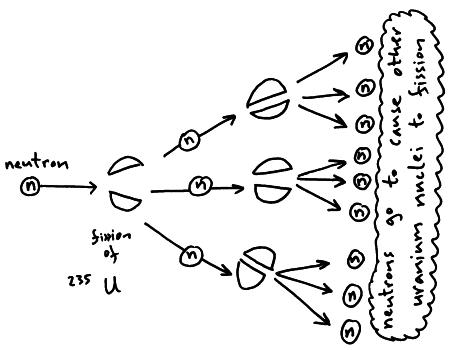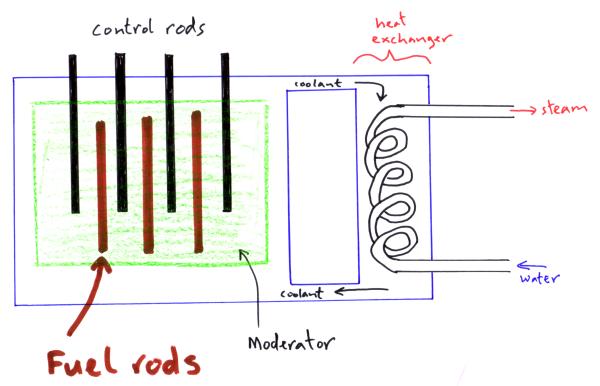Thermal nuclear reactors.
Nuclear fission of uranium-235 can be triggered by the nucleus absorbing a neutron.

The uranium splits up into two lighter nuclei (barium & krypton) and 2 neutrons are released. These two neutrons can collide with other uranium nuclei to cause more fission. This process is called a chain reaction.

If there is only a small amount of uranium most of the neutrons will leave the material without colliding with other uranium nuclei. So for a chain reaction the uranium must be above the critical mass (this miniumum mass required for a chain reaction to take place).

The fuel rods in a reactor contain the uranium used in nuclear fission.
The neutrons produced during fission are fast moving and so to increase the probability of a neutron entering a nucleus they must be slowed down by the moderator. Slow moving neutrons are called thermal neutrons.
The moderator could be graphite or even water. The factors affecting the choice of material for the moderator are;
- they should be available in large amounts
- they should have a small/light nuclei
- they should not become radioactive when bombarded with neutrons
- if a solid is used it should have a high melting point
The control rods can be moved into and out of the core to slow down or speed up the rate of the nuclear fission. They control rods achieve this by absorbing neutrons. The control rods can be made of boron or cadmium. The factors affecting the choice of material for the control rods are;
- the material must absorb neutrons
- have a high melting point
The coolant in the reactor which can be water or carbon dioxide gas. Removes the heat energy from the reactor before the heat energy is transfered to water in the heat exchanger. The factors affecting the choice of coolant are;
- it should have a high specific heat capacity
- be non-corrosive
- be stable at high temperatures
The water which is heated by the coolant in the heat exchanger becomes steam which turns a turbine which is connected to a generator which them produces the electricity for the consumer.



